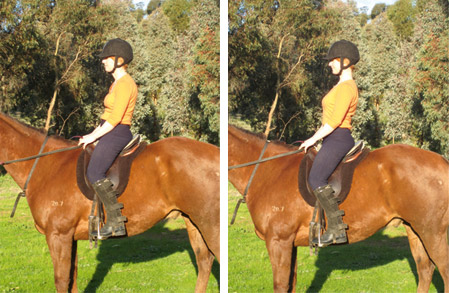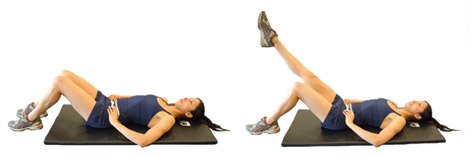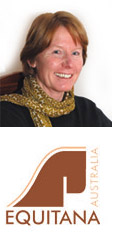|
Pilates for the Horse Rider
By Annette Wilson
During a riding lesson it is common to hear and witness or experience an instructor telling the rider to keep their shoulders square, soften their hands, use more leg, keep their seat in the saddle, stop bouncing at the sit trot, stop moving their leg, use more seat…more impulsion…more bend, etc etc. The rider, frustrated and trying as hard as they know how, often compounds the problem by stiffening up through the whole body and blocking the horse’s movement, as well as their own. Riders end up paying for many lessons with the same results.
Does this sound familiar?
Many instructors see the problem but lack the knowledge on HOW to fix it. Riders are beginning to realise that the average riding instructor does not have the education to train them in posture. The ability to sit well in the trot and have a deep, independant seat will not be taught by an instructor. To achieve a strong but flexible upright seat in the saddle and keep the legs still through all paces and aids, are elements of riding that riders need to address, themselves. All these movements are based around the strength and use of the deep core muscles.
Training to develop core stability will greatly improve every rider’s seat. Riding lessons will become progressive, with the horse improving in obedience, less resistance to poor aids and the rider becoming more skilled and confident.
Core stability and strength can be trained in the gym or Pilates classes, however these sessions will not train functional riding movement patterns; a rider needs to learn specific horse riding movement patterns in order to ride with skill. Riders must learn how to use their strength, not just be strong. Applied Posture Riding is the perfect way to apply Pilates to riding.
Pilates has become a very popular exercise routine for both the general public, and for sports people. While most may have heard of Pilates, many don’t actually know what it is or understand its principles.
What is Pilates?
Over the years professional people have discovered special features about individual muscles and these discoveries are generally named after the person who actually made a difference by studying that muscle. Joseph Pilates was the man who discovered the special features and function of the deep Transverse Abdominal Muscle, which is a postural muscle that runs transversely around the belly. It does not move any joints or body parts; its main function is to stabilise the spinal joints, and flatten the tummy. This is known as core stability, making the Traverse Abdominal the single most important muscle for posture and pain control.
Unfortunately, due to a gap in the knowledge of many gym and Pilates teachers, the true function of this muscle and its bio-mechanics is not well understood. The teaching of core stability is generally not complete as it must be taught by an expert. In reality, a Pilate’s class should be no different to any other class, because every person exercising, working, or just walking around should be engaging their core muscles. Pilates classes should be called posture classes.
Pilates is the function of the deep core abdominal muscles and simply drawing in one’s ‘tummy’ in preparation for doing an exercise is NOT Pilates. It is a good start, but more education on HOW and WHY is not taught. It is important to know if the transverse abdominal muscle is working properly, and even more important to know if it isn’t. Core stability must be learned from an expert, to be performed properly.
Core Stability and the Horse Rider
Horse riding looks so easy, but those who ride know better. Sitting on a horse requires energy on its own, and asking a horse to perform requires much more effort. Riding requires control, strength and symmetry from both sides of the body. It is essential to have strength, coordination, feel and precision from all body parts. Control, independent movements and strength will all improve with good core stability.

Left: Slumped. Just sitting on a horse requires effort but core strength can
improve
a rider’s seat and effectiveness with aids. Right: Core muscles engaged.
The influence of PAIN
Many factors inhibit core strength. Lower back pain is a huge inhibitor in training the transverse muscle and many horse riders suffer back and or neck pain. Severe stiffness will create pain and hence, weakening of the core. These problems are self-feeding; that is, cause and effect run the circle: pain causes inhibition, this causes a weakness and weakness results in poor control and stability, then again, causing pain. The cycle must be broken. Managing pain is another topic on its own but the first step is to start training core stability and understand the HOW.
Women have the greatest challenge post child-birth as the separation of the front muscles and the regaining of strength is such a battle. Training the transverse abdominal muscle is the very first step for women returning to riding, post birth.
Coordination
Horse riding is very different to ball or athletic sports. The riding posture is very static (but mobile) and should appear to be still. Ball - and all athletic sports - are dynamic, which means fast-moving in many directions. Most sports are one-sided, using the dominant side repetitively, e.g. tennis, and eye-hand coordination is very important. Horse riders, on the other hand, need to feel movement through their seat, and this does not come naturally to many. Riders need to be equally talented with both the left and right sides of the body; people generally find it difficult to coordinate their left and right hands at the same time (rub their belly while patting their head), let alone coordinating feet, hands and seat, all together.
Good Riders
When what is required to ride well is analysed, it’s easy to understand why riding isn’t that easy. Good riders make it appear easy, but why?
The good riders have a natural feel for the movement of the horse through their seat; they also move with the horse well and are one unit.
An effective learning technique is to observe and study the posture of a good rider when they’re out of the saddle. Watch how they stand, how they walk, how they move. Many are naturally straight in the back and flexible in their movement patterns. If they were tested for strength and stability, the results would most likely be good as having strong core stability allows these riders to move their limbs independently, and this equates with the ability to apply precise, independent aids. These riders would also be generally fit and have good muscle endurance plus endurance and strength in all their posture muscles.
Learn to Ride Better
If a rider is having performance problems they need to look at themselves before blaming the horse. It does not take a huge effort to do some self-testing of one’s postural muscles, joint flexibility, and specific riding muscle strength.
Knowledge of how and when each of the major riding muscles is used is a great advantage to any rider. Applied Posture Riding teaches riders about their riding muscles: how to test them, what their function is, and how to train them individually. The techniques teach specific movement patterns, and how to use the deep core muscles for riding.
There are many skills a rider can learn while off the horse. A rider will do some self-testing and identify their own faults; once these are identified they can focus on certain exercises to retrain their muscles. The absolute, most-important muscle to train and learn how to engage is the deep core abdominal muscle. The rider can then be taught how to use this power in the saddle, however, this cannot be taught by a gym trainer or aerobics teacher.
Simple test for Core Strength.
First Exercise: Lay on your back on the floor, with knees bent up and feet flat on floor.
Put your fingers on your hip bones
and press gently.
Very slowly lift one leg up so the hip is at 90-degees. As the foot comes off the ground, feel what happens to the hip bones with respect to movement (the hip of the leg coming off the ground will most likely drop toward the floor).
There should be NO movement if the core muscle is strong and engaged. If the hips move, the core is either not engaged or not strong enough.
Second Exercise: Repeat, but try using your core. Same position, but before lifting the foot, gently blow out and draw your tummy in below your belly button. Hold and lift the leg again. Keep breathing.
If the hip moves again you have not engaged the core muscle, you have only tightened the other abdominals.
Many report this is the instruction given in most Pilates classes. It is not enough for most sports people and especially not enough for horse riders.The ability to hold the core strong while performing a movement pattern will increase strength and protect the back. This can be learned and used in riding.

A Simple Exercise in the Saddle.
At the Walk (this is from the Applied Posture Riding program). First of all, be safe, and have someone lead the horse if necessary.
To begin: Dangle the feet out of the stirrups. Hold the reins safely but have a little contact. Sit tall and close your eyes. Feel the movement of the horse’s hind legs - your hips should follow the hind leg movement. One seat bone will lift and roll forward as the horse steps through (leg off the ground). The other seat bone will drop as the hind leg is stepped over (leg on the ground).
This will cause your lower back to tilt from side to side, and rotate forward. You upper back should move in the opposite (counter) movement pattern. Repeating and concentrating on feeling this will make it more and more clear.
The rider should move in tune with the horse, but appear still. You are never still when riding. This should be the case in all paces.
Learn to feel movement by understanding the beat of each pace. There are many more specific tests and movement patterns to learn, to improve one’s riding. In the Applied Posture Riding program a large gym or Physio ball is recommended. This is the ideal too to train horse riders’ specific movement patterns, and core stability. Once a movement pattern has been established, it will become natural.The trot, both sitting and rising can be trained on the ball, if the trainer knows the correct movement patterns. The sit trot can be taught by learning how to engage the deep core muscles and coordinate the breathing pattern with the two-beat foot fall pattern; once learned, the breathing pattern can be dropped because the sit trot is established. The canter can be simulated, with certain exercises, just as easily.
Pilates is simply learning HOW to initiate, test, train and function with core stability. The use of core stability in horse riding is more complicated than just doing Pilates-based exercises.
 ABOUT THE AUTHOR: ABOUT THE AUTHOR:
Annette Wilson
Annette has a Masters degree in Physiotherapy and is a Pilates Educator. Her education, skills as a teacher, and experience as an elite equestrian competitor have given her the knowledge and experience to teach riders about their own posture. Annette is the author of Applied Posture Riding. The Applied Posture Riding program, available as a package which includes the E-book and DVD series, was designed specifically for horse riders.
www.applied-posture-riding.com
Annette will be a presenter at Equitana Melbourne, from the 18th to the 21st Nov 2010, at the Melbourne Showgrounds.
www.equitana.com.au.
|